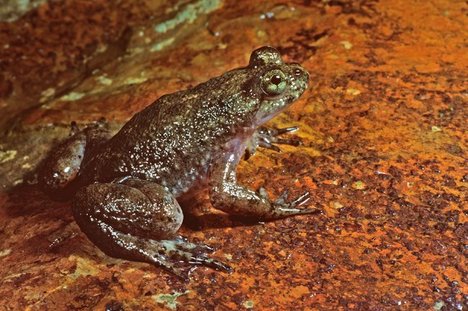“The Southern gastric brooding frog, extinct for a quarter-century. Scientists made early embryos of the frog but they died.” Source of caption and photo: online version of the NYT article quoted and cited below.
(p. A1) Last week at a conference in Washington, scientists from Australia reported on their attempt to bring back a weird frog, the Southern gastric brooding frog, that went extinct about a quarter century ago. So far they have only made early embryos, which have died.
It is the early days for this new endeavor — it could be years before scientists succeed in bringing species back from extinction. But many species are now gleams in scientists’ eyes as they think of ways to bring them back. Woolly mammoths. A 70,000-year-old horse that used to live in the Yukon. Passenger pigeons, a species that obsessed Dr. Church’s former student.
. . .
(p. A16) Before humans killed them, the nation had three billion to five billion passenger pigeons. They would take days to cross a city, noted Hank Greely, the director of the Stanford Center for Law and the Biosciences at Stanford University. “They left cities covered in an inch of guano,” he said.
. . .
But there could be some unexpected advantages to bringing back certain species, or even to adding their DNA to that of today’s species, Dr. Church said. For example, suppose elephants could live again in the Arctic. When woolly mammoths lived in the Arctic they would knock down trees and enable Artic grasses to flourish. Without trees, more sunlight was reflected and the ground was cooler. In winter, they would tramp down snow into the permafrost, enhancing it.
“Permafrost has two to three times more carbon than all the rain forests put together,” Dr. Church said. “All you have to do to release carbon dioxide and methane is to melt it. With rain forests you have to burn it.”
. . .
Mr. Greely cited another argument in favor of bringing back extinct species. He did not quite buy it, he said, but for him it had “a visceral appeal.”
It is an argument about justice. Take the passenger pigeon. “We are the murderers,” Mr. Greely said. “We killed them off. Shouldn’t we bring them back?”
For the full story, see:
GINA KOLATA. “So You’re Extinct? Scientists Have Gleam in Eye.” The New York Times (Tues., March 19, 2013): A1 & A16.
(Note: the online version of the story has the date March 18, 2013.)
(Note: ellipses added.)

